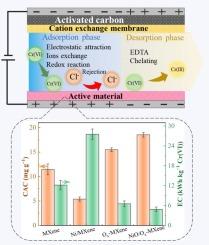Selective chromium removal and detoxification via capacitive deionization using nickel oxide-loaded oxidized MXene electrode: The critical role of Ti/Ni dual-redox centers
IF 9.8
1区 工程技术
Q1 ENGINEERING, CHEMICAL
引用次数: 0
Abstract
The selective removal and detoxification of hexavalent chromium (Cr(VI)) from industrial wastewater remains a pressing challenged due to the interference of coexisting ions. Herein, we present a redox-engineered material, nickel oxide nanoparticle-loaded oxidized MXene (NiO/Ox-MXene), as an innovative electrode for capacitive deionization (CDI) to enable efficient and selective Cr(VI) capture and transformation. By employing a facile potassium persulfate oxidation strategy at ambient conditions, titanium vacancies on MXene nanosheets were converted into multivalent titanium oxide domains, while NiO nanoparticles were simultaneously coated forming a dual redox-active interface (Ti3+/Ti4+ and Ni2+/Ni3+). This heterostructure significantly lowered the interfacial charge transfer resistance by 67 %, thereby, enhancing electrochemical performances and ion capture kinetics. The optimized NiO/Ox-MXene electrode delivered a Cr(VI) adsorption capacity of 18.54 mg g−1 at 0.9 V, outperforming that of pristine MXene by 1.6-fold, while reducing Cr(VI) concentrations from 5 to 0.06 mg L−1 with a low energy consumption of 4.85 kWh kg−1 Cr(VI). Notably, the system maintained high selectivity even in the presence of competitive Cl−, NO3−, SO42− anions, with selective factors of 83.81, 83.10, and 44.79, respectively. It also retained 82.78 % Cr(VI) removal efficiency after five operational cycles. Mechanistic analysis revealed that Cr(VI) removal was governed through synergistic combination of electrostatic adsorption, ion exchange, and surface complexation, and redox-mediated electro-reduction to less toxic Cr(III) via interfacial electron transfer at Ti/Ni dual-redox centers. This work established a scalable and chemically robust CDI platform for targeted Cr (VI) remediation, providing a blueprint for rational electrode design towards selective heavy metal remediation from complex water matrices.

利用负载镍的氧化MXene电极通过电容去离子选择性去除铬和解毒:Ti/Ni双氧化还原中心的关键作用
由于共存离子的干扰,工业废水中六价铬(Cr(VI))的选择性去除和解毒仍然是一个紧迫的挑战。在此,我们提出了一种氧化还原工程材料,氧化镍纳米颗粒负载氧化MXene (NiO/Ox-MXene),作为一种创新的电容去离子(CDI)电极,以实现高效和选择性的Cr(VI)捕获和转化。通过在室温条件下采用过硫酸钾氧化策略,MXene纳米片上的钛空位转化为多价氧化钛结构域,同时NiO纳米颗粒被包覆形成双氧化还原活性界面(Ti3+/Ti4+和Ni2+/Ni3+)。这种异质结构显著降低了67%的界面电荷转移电阻,从而提高了电化学性能和离子捕获动力学。优化后的NiO/Ox-MXene电极在0.9 V电压下的Cr(VI)吸附量为18.54 mg g−1,是原始MXene的1.6倍,同时将Cr(VI)浓度从5降低到0.06 mg L−1,能耗为4.85 kWh kg−1 Cr(VI)。值得注意的是,该体系在Cl−、NO3−、SO42−阴离子竞争条件下仍保持较高的选择性,选择因子分别为83.81、83.10和44.79。5个循环后,Cr(VI)的去除率仍保持在82.78%。机理分析表明,Cr(VI)的去除是通过静电吸附、离子交换和表面络合的协同作用进行的,并且通过Ti/Ni双氧化还原中心的界面电子转移,氧化还原介导的电还原为毒性较小的Cr(III)。本研究建立了一个可扩展的、化学稳定的靶向Cr (VI)修复CDI平台,为从复杂水基质中选择性修复重金属提供了合理的电极设计蓝图。
本文章由计算机程序翻译,如有差异,请以英文原文为准。
求助全文
约1分钟内获得全文
求助全文
来源期刊

Desalination
工程技术-工程:化工
CiteScore
14.60
自引率
20.20%
发文量
619
审稿时长
41 days
期刊介绍:
Desalination is a scholarly journal that focuses on the field of desalination materials, processes, and associated technologies. It encompasses a wide range of disciplines and aims to publish exceptional papers in this area.
The journal invites submissions that explicitly revolve around water desalting and its applications to various sources such as seawater, groundwater, and wastewater. It particularly encourages research on diverse desalination methods including thermal, membrane, sorption, and hybrid processes.
By providing a platform for innovative studies, Desalination aims to advance the understanding and development of desalination technologies, promoting sustainable solutions for water scarcity challenges.
 求助内容:
求助内容: 应助结果提醒方式:
应助结果提醒方式:


